Julian Nagelsmann has long been lauded as one of the most interesting young coaches in football, at least from a tactical perspective, but there was always a sense that he had yet to show this at the very highest level of football. Indeed, this season there have been rumblings of discontent coming from the Bayern Munich supporters as, despite an impressive start to the season, they had drawn their last three league matches. Despite underlying data that suggests that they should be doing much better in the league the results on their own have led to some wondering if the young German coach would see out the season in Munich.
This was the backdrop in which this week’s Champions League matches were played and, as Bayern prepared for the visit of the Spanish giants Barcelona, there was a degree of uncertainty around the squad not least due to the fact that Bayern’s former talismanic forward Robert Lewandowski would be lining up in this match for the opposing side. It felt like a bold move in the summer when Bayern agreed to sell the Polish international striker to the Spanish side and it has since emerged that Nagelsmann played a role in the decision by telling the decision makers at Bayern that he believed they would be just as successful without Lewandowski and that he did not actually need a ‘fixed striker’ in his squad.
In isolation, a 2-0 win for Bayern Munich in this match looks like business as usual, at least in the context of the last few seasons in the UEFA Champions League, but in this instance, the scoreline very much fails to tell the whole story. Indeed, this match appears to epitomise the term ‘a tale of two halves’ as Barcelona under their Spanish coach Xavi will feel extremely aggrieved to have not gone in at the half-time break at least a goal ahead. In the end, however, Nagelsmann came out on top with some intelligent changes from a tactical perspective to give his side the edge and create space in the final third in the second half of the match.
In this tactical analysis, we will break down the key tactical concepts from this game. It will be an analysis of the tactics from the game, looking at how Nagelsmann got one over on Xavi.
Team News
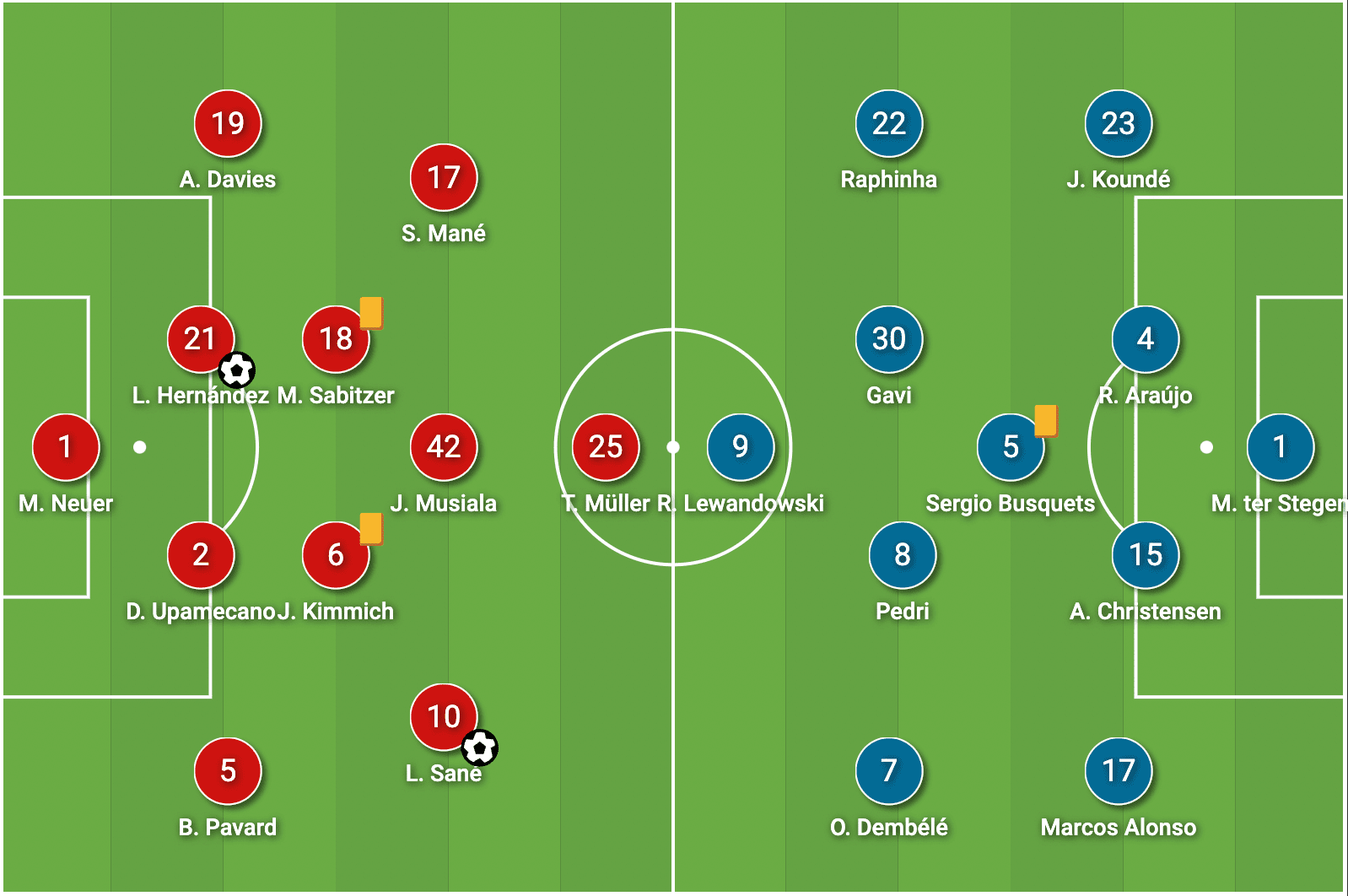
Team news first and there was an immediate surprise from Nagelsmann in the starting positions of his attacking players. While Thomas Muller, Sadio Mane, Jamal Musiala and Leroy Sane have been regular starters in the attack for Bayern so far this season they have typically played with a more fluid front three of Sane, from the left, Musiala, from the right and Mane, through the centre, with Muller as the 10.
In this match, the positions were switched with Mane and Sane on the left and right of the attack respectively and Thomas Muller playing as the more advanced forward. These moves were likely deliberate by Nagelsmann to ensure that Bayern had speed in the wide areas to deal with the threat posed by the Barcelona wingers.
For Barcelona, the lineup was pretty much as expected with the key positions being filled by Robert Lewandowski, as the central striker, Raphinha and Ousmane Dembele as the wide attackers. Pedri and Gavi played as the free ‘8’s in Xavi’s preferred 4-3-3 system.
Early dominance from Barcelona
In the early stages of this match, Barcelona were very much on the front foot with an extremely energetic opening half an hour as the Spanish side looked to press as high up the pitch as possible in order to prevent Bayern from playing out from the back and building their attack.
So far this season we have tended to see Bayern line up in this 4-2-3-1 system with the two pivot players in the centre of the midfield, Joshua Kimmich and Marcel Sabitzer, in this match Bayern struggled to find a way in the early stages to progress the ball from the back and into these two players in the midfield area.
This was because Barcelona were simply so aggressive in their pressing approach. The young Spanish international midfielder Gavi was especially important as out of possession his positioning was dynamic in terms of pushing forward and supporting Lewandoski in the centre of the pitch. This forward movement from Gavi essentially allowed the two wide attackers from Barcelona to go push on and pick up the Bayern fullbacks man to man.
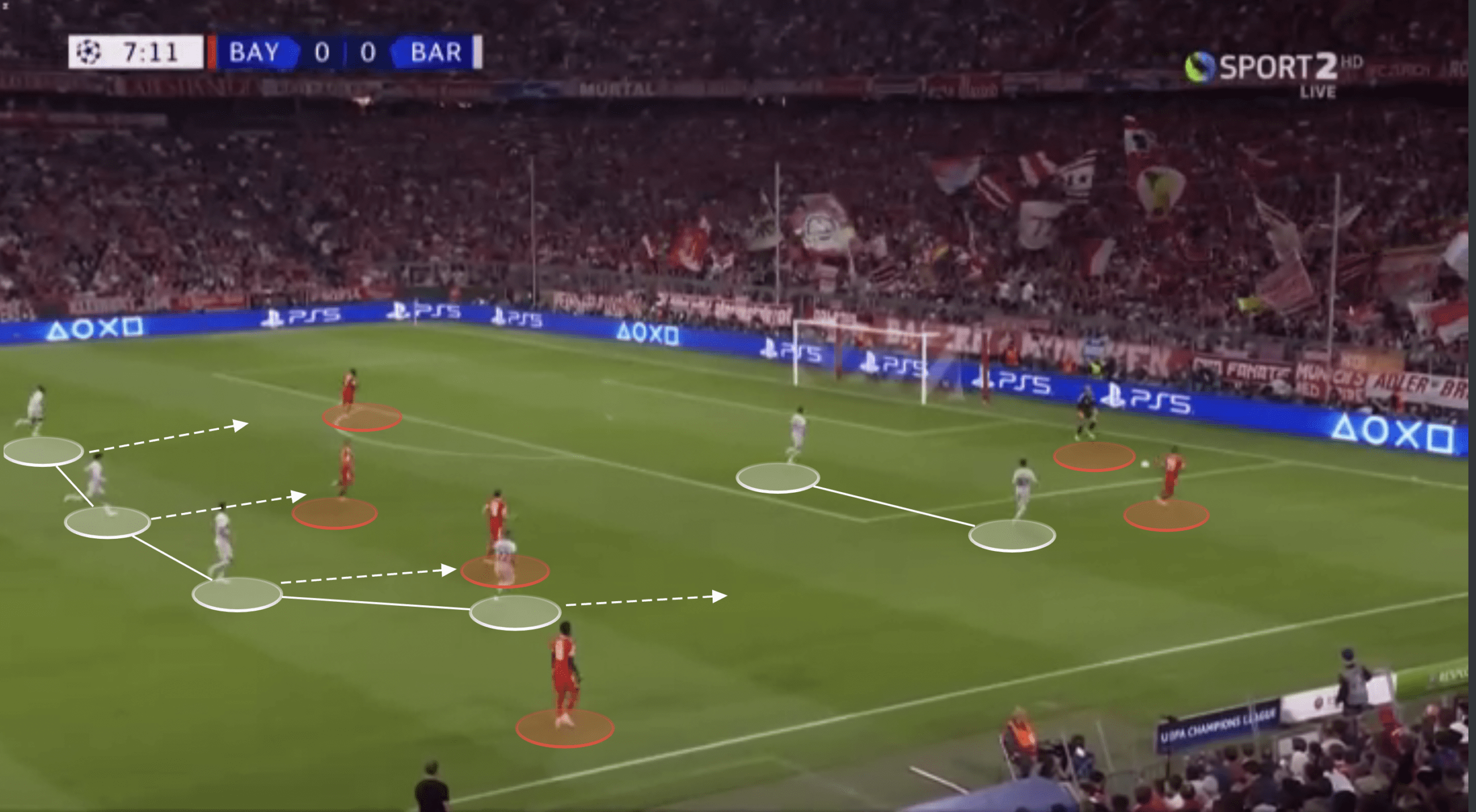
Bayern are typically used to progressing the ball aggressively and breaking teams down by playing through the line of pressure but, at least for the first 35 minutes or so in this match, Barcelona essentially choked the life out of them as they were looking to create the attack and the German side made far more mistakes in the build-up than we would typically see.
In this match, we see the press in effect as the two Barcelona players, Lewandowski and Gavi have pressed up high to go 2v2 as Bayern look to get the ball back. In this position, we would typically see Bayern then open out the angle before playing out to the opposite side in order to play through the pressure. The second line of the pressure from Barcelona, however, was so effective over the first part of this match that Bayern were forced to either go long or make a mistake more often than not when they were looking to bring the ball out.
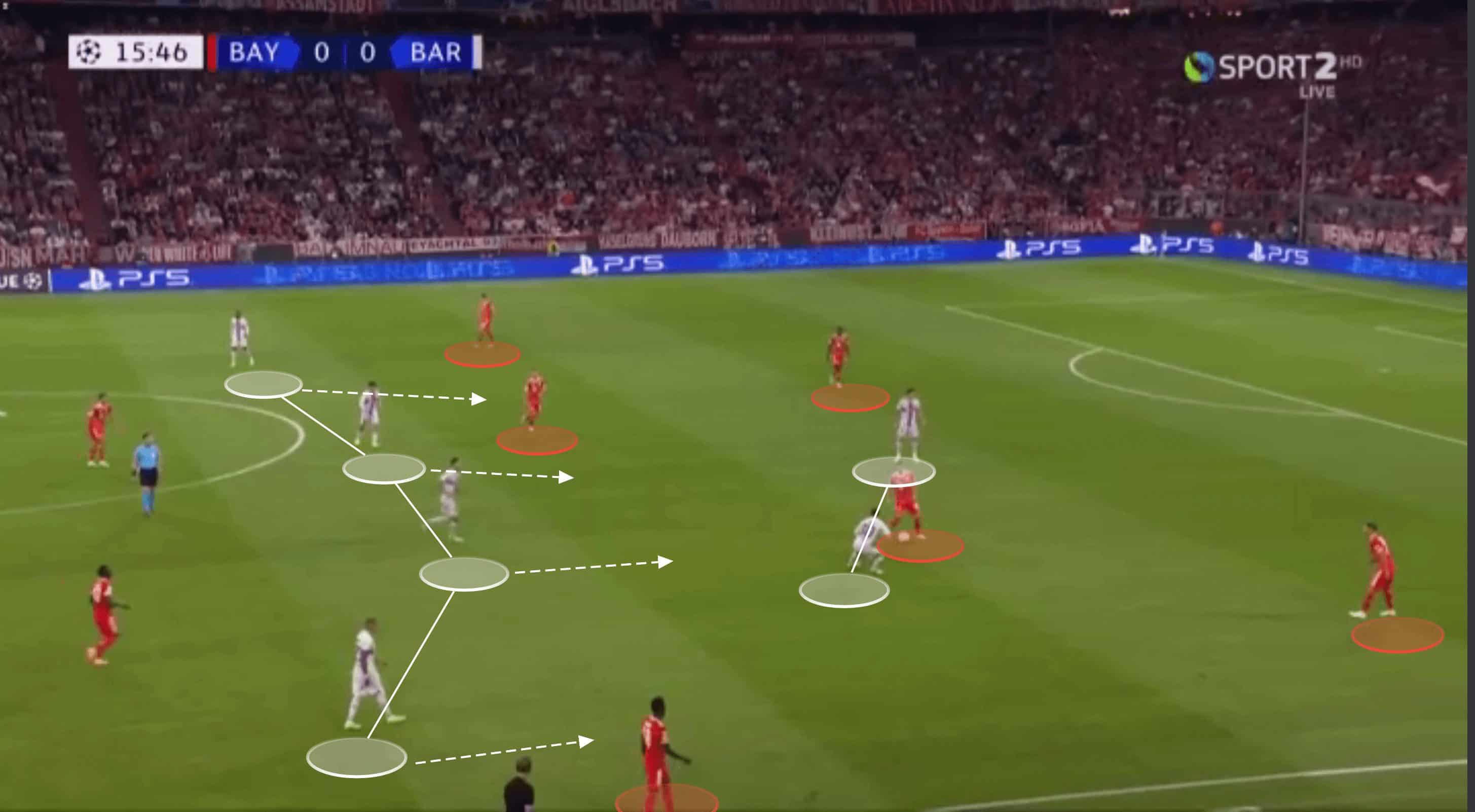
We see a similar situation here as Barcelona again press up aggressively and prevent Bayern Munich from playing through the pressure and into the middle third of the pitch.
The fact that Barcelona were so effective in the opening stages of this match in terms of disrupting the Bayern attack has essentially meant that the German champions were not able to progress the ball forward cleanly. This was further exacerbated by the fact that Raphinha, on the Barcelona right, was looking to stay so high in and out of possession and as such the flying Canadian fullback Alphonso Davies could not step out and affect the game on a higher line.
Typically, when Bayern are in the attacking phase of the game, we will see Davies move high and the left-sided attacker occupies the half-space. The picture is different on the opposite side as Benjamin Pavard stays deep, and effectively forms a back three. This was mitigated somewhat in the first half when Pavard was replaced by the more attack-minded Noussair Mazraoui.
Barcelona look to attack wide and high
In the modern game, there tends to be two very distinct approaches to how a team plays in the final third when they have wingers. There is the ‘Liverpool approach’ of the last few years where the two wide attackers look to come inside and occupy the half-spaces or even the central areas in the attacking phase or there is the very opposite approach when the wide attackers stay outside and essentially stretch the game out.
In this match we saw Barcelona look to take the second approach with their two wingers, Dembele and Raphinha, playing wide. This was intended, at least in part, to prevent the Bayern fullbacks from getting into any kind of attacking positions and in the early stages of the game, it was very effective. It was perhaps more effective because Dembele, playing from the left, still shifted in and out of the half-spaces before then moving outside in possession to attack the fullback.
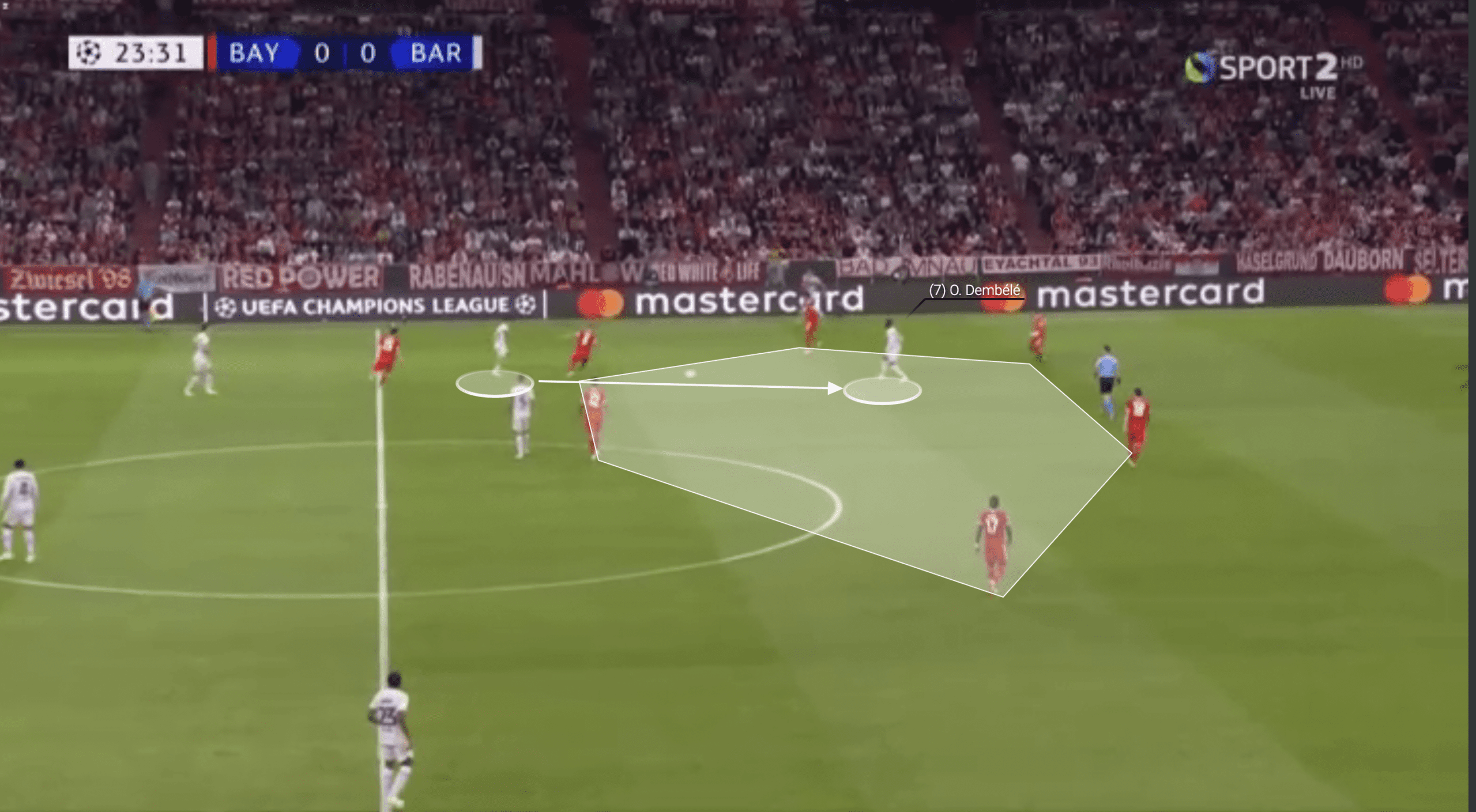
While Bayern were struggling to find ways to break through the Barcelona press and into the final third we saw Barcelona consistently find ways to break through and into the final third as they were in the attacking phase. We see an example here of the positioning of Dembele in pockets of space in the final third. As the French international wide player receives the ball, he is in between six opposition players and when taking the ball in these areas, he will act aggressively in terms of carrying the ball and running and the isolated defensive player.
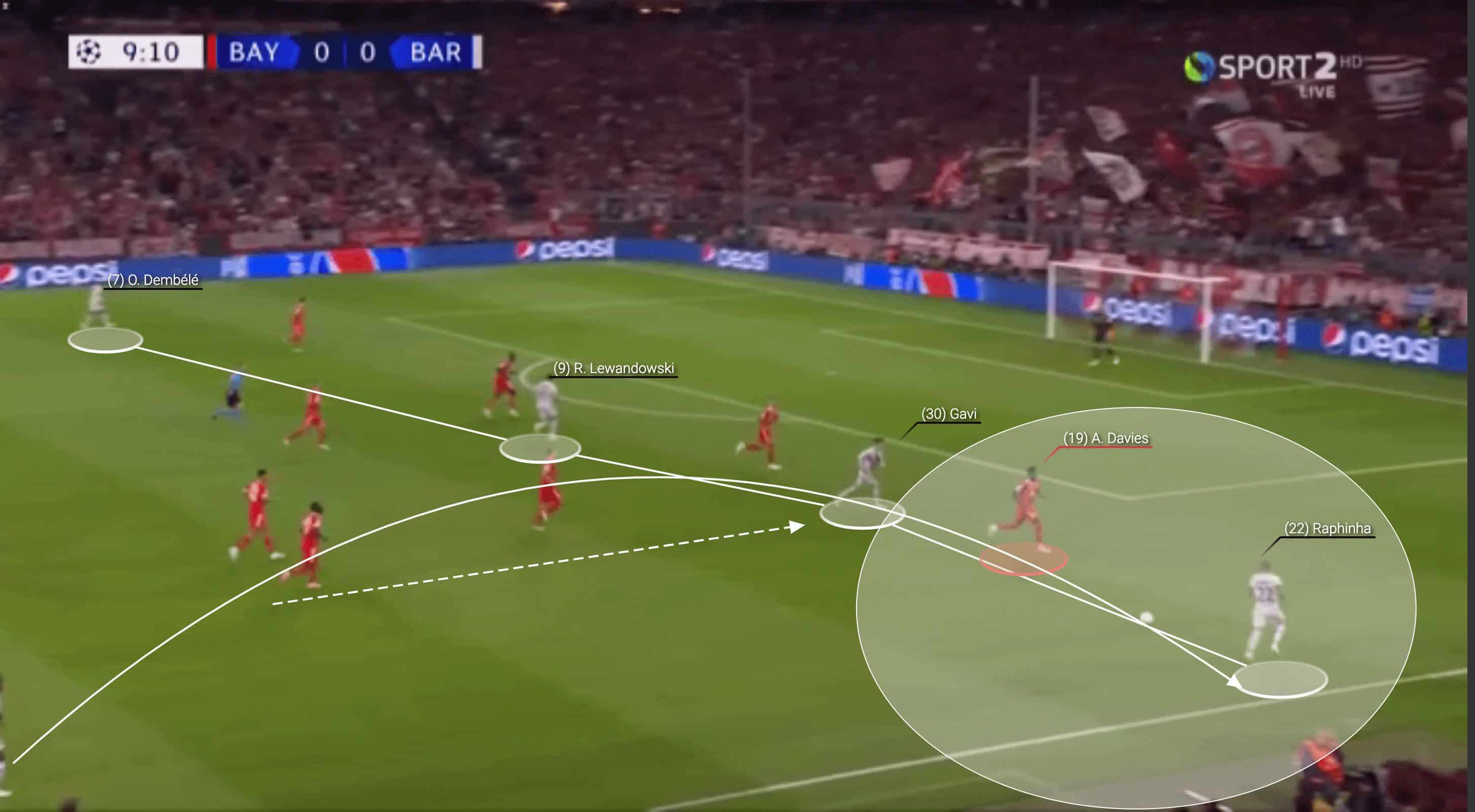
This time, we see the situation as the ball is played forward and into the Brazilian international Raphinha, who is positioned wide on the right-hand side of the attack. The key thing to note here is that Gavi has moved high into a position to support the attacking line and Dembele is positioned wide on the left. The wide positioning of the two wide forwards from Barcelona in these situations essentially stretched out the defensive line of the opposition and created space between the Bayern Munich defensive players.
Mazraoui starts to find space
In our opinion, Bayern Munich pulled off one of the best pieces of transfer business in the summer transfer window when they announced the free transfer of the Moroccan international right-back Noussair Mazraoui from Ajax. Over the last two or three seasons, we had seen Mazraoui develop into one of the most tactically fluid and dynamic fullbacks in football and there is a real sense that if he had not already moved, he would have been one of the first targets for Erik ten Hag after the Dutchman took over the Manchester United job.
So far in Germany, we have seen Mazraoui used sparingly as Nagelsmann, and indeed the Bayern hierarchy, like the defensive stability that Benjamin Pavard offers at the right-back position. In this match, however, we clearly saw the importance of having a player like Mazraoui whose tendency to play inverted from the fullback position allows Bayern to find angles to play more progressively and to break the pressure of the opposition.
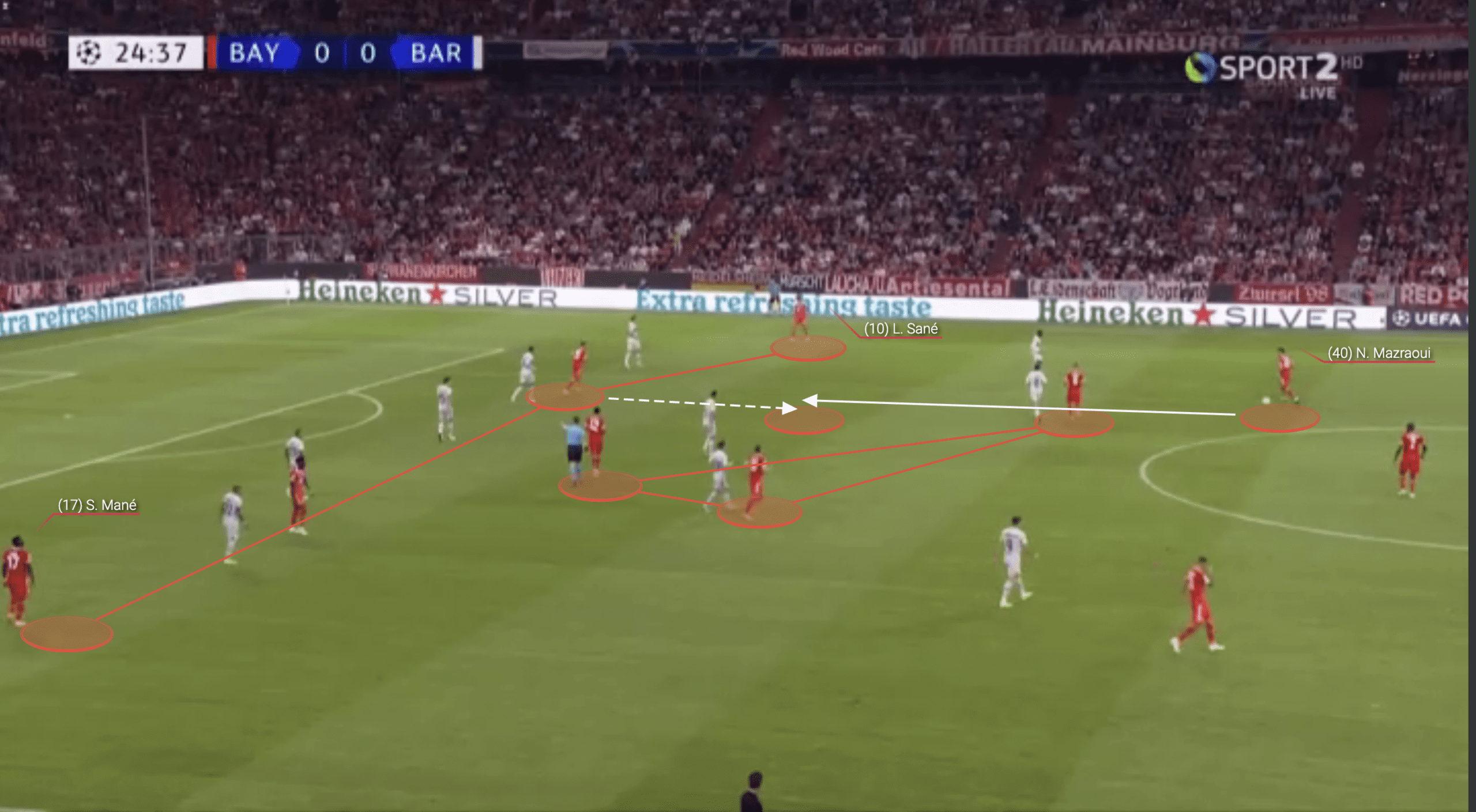
We almost immediately saw the difference when Mazraoui came on to replace Pavard halfway through the first half and the Moroccan international got on the ball in some really dangerous positions in the half-space on his side of the pitch. In the example above we see this in action with Mazraoui positioned in that half-space and on the ball. From these areas, Bayern were able to commit more players to the attacking line, with Alphonso Davies doing so this time, and Mazraoui had the quality on the ball to play drive-through passes that broke the line of pressure from the opposition.
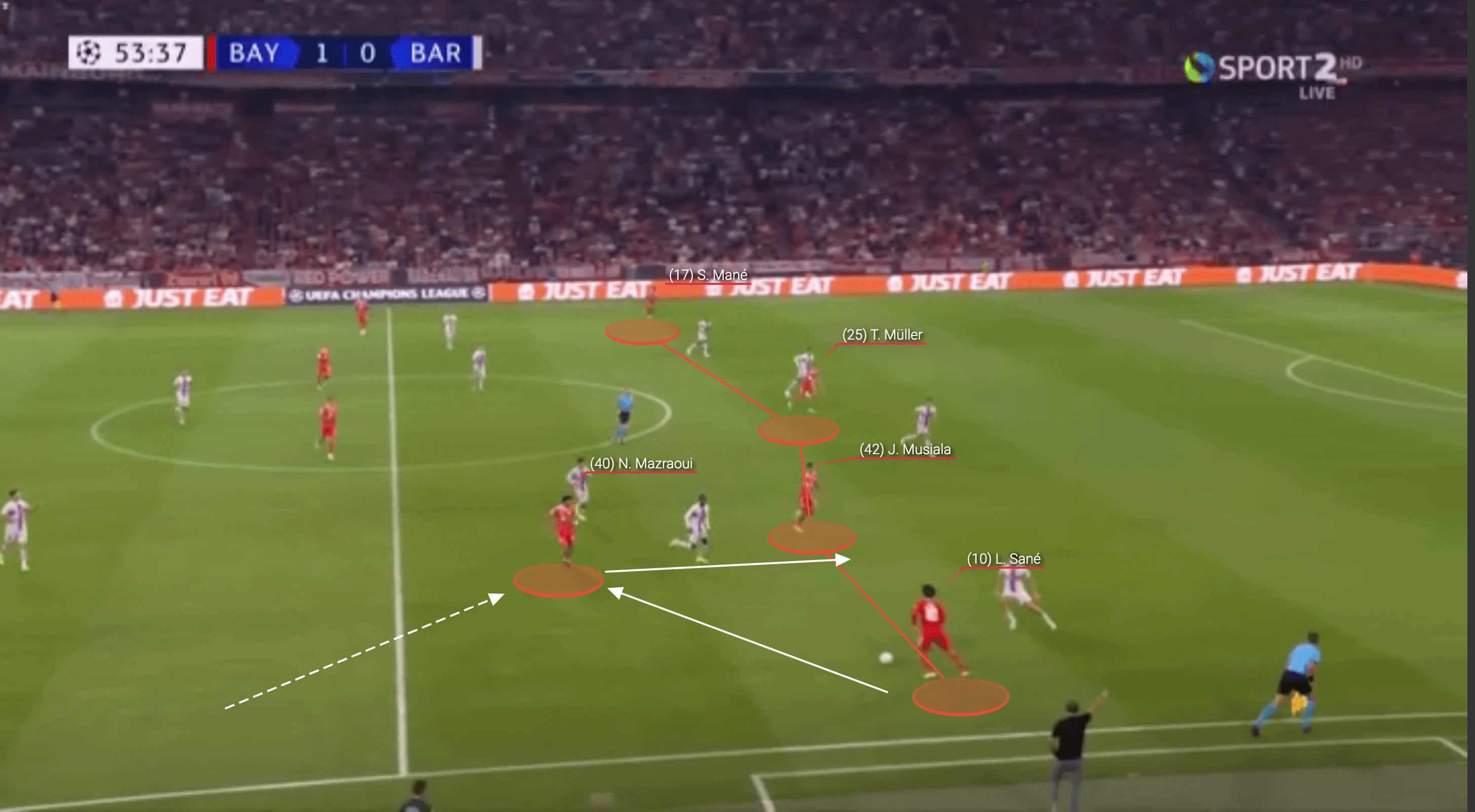
Here again, we see the importance of the positioning of Mazraoui in the inverted fullback position when it came to allowing Bayern to play progressively and to break down the defensive structure of Barcelona. This is actually the lead-up to the first Bayern goal, which would be scored by Leroy Sane (in possession). As the ball was played forward from Upamecano from the right-sided central defender position to Sane, we had already seen Mazraoui move inside to open that passing lane and take up a position in the half-space.
His positioning allows Sane to pick up the ball and then quickly drop it off to Mazraoui before making an aggressive off-the-ball move. The Moroccan fullback then plays forward quickly and unlocks the space in the final third.
Bayern emulate Barcelona to create space
We have already spoken about the fact that one of the keys to Barcelona’s early dominance was the way that they left their wide attackers high and wide to stretch the play. This is not actually similar to the way that Bayern Munich typically play as they look to overload the central areas and the half-spaces with a lot of attacking players looking to rotate and move into the central areas of the pitch in order to break down opposition teams. In this match, however, we saw Naglesmann make changes at half-time to leave his wide players out and create huge amounts of space centrally.
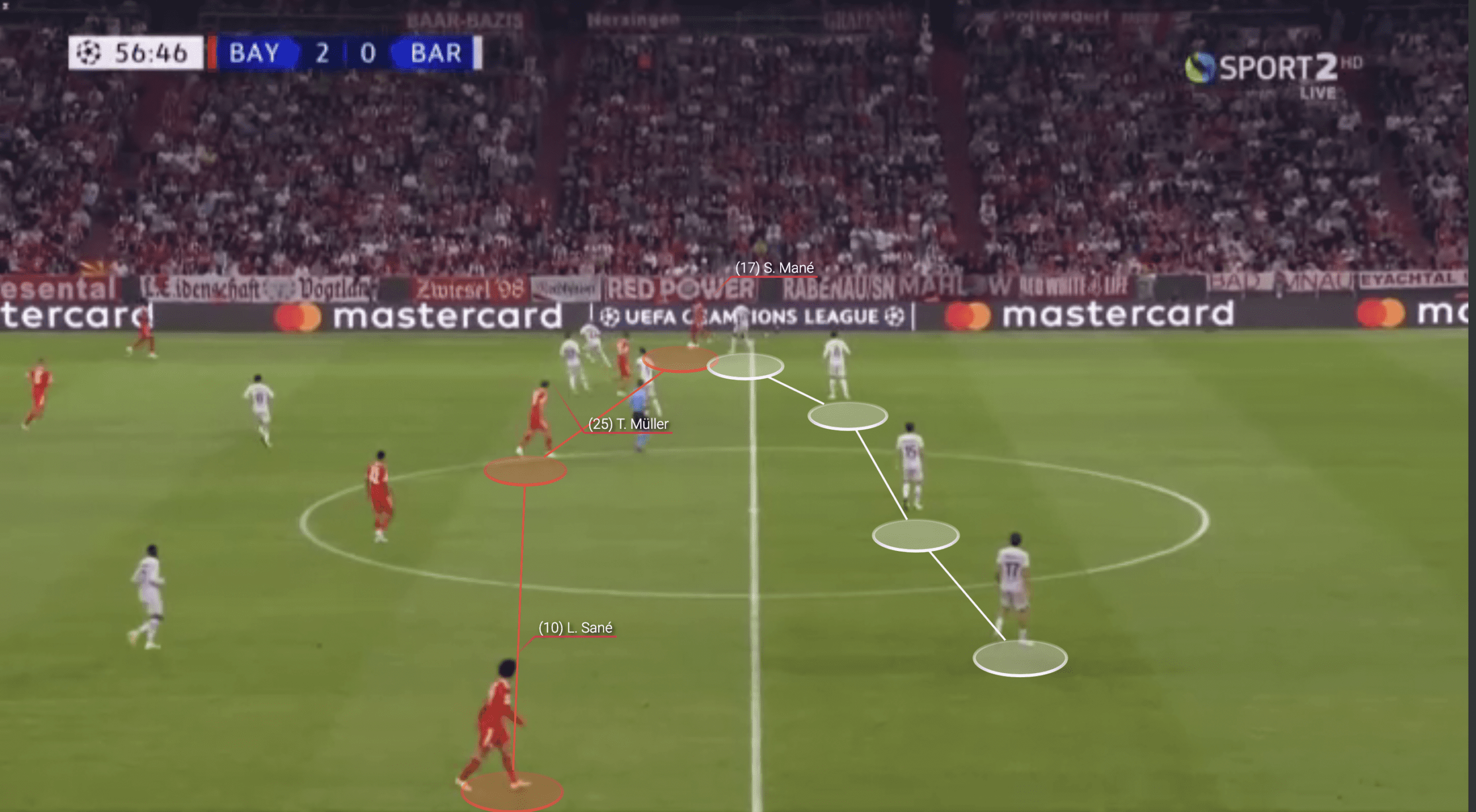
We see the start of this in this image with Sadio Mane in possession on the far side of the pitch. Look now at the positioning and spacing of the forward players for Bayern Munich as they are positioned across the width of the pitch. From these positions, as the second half wore on, we saw the German side able to take advantage of the spaces that they had created in the opposition half.
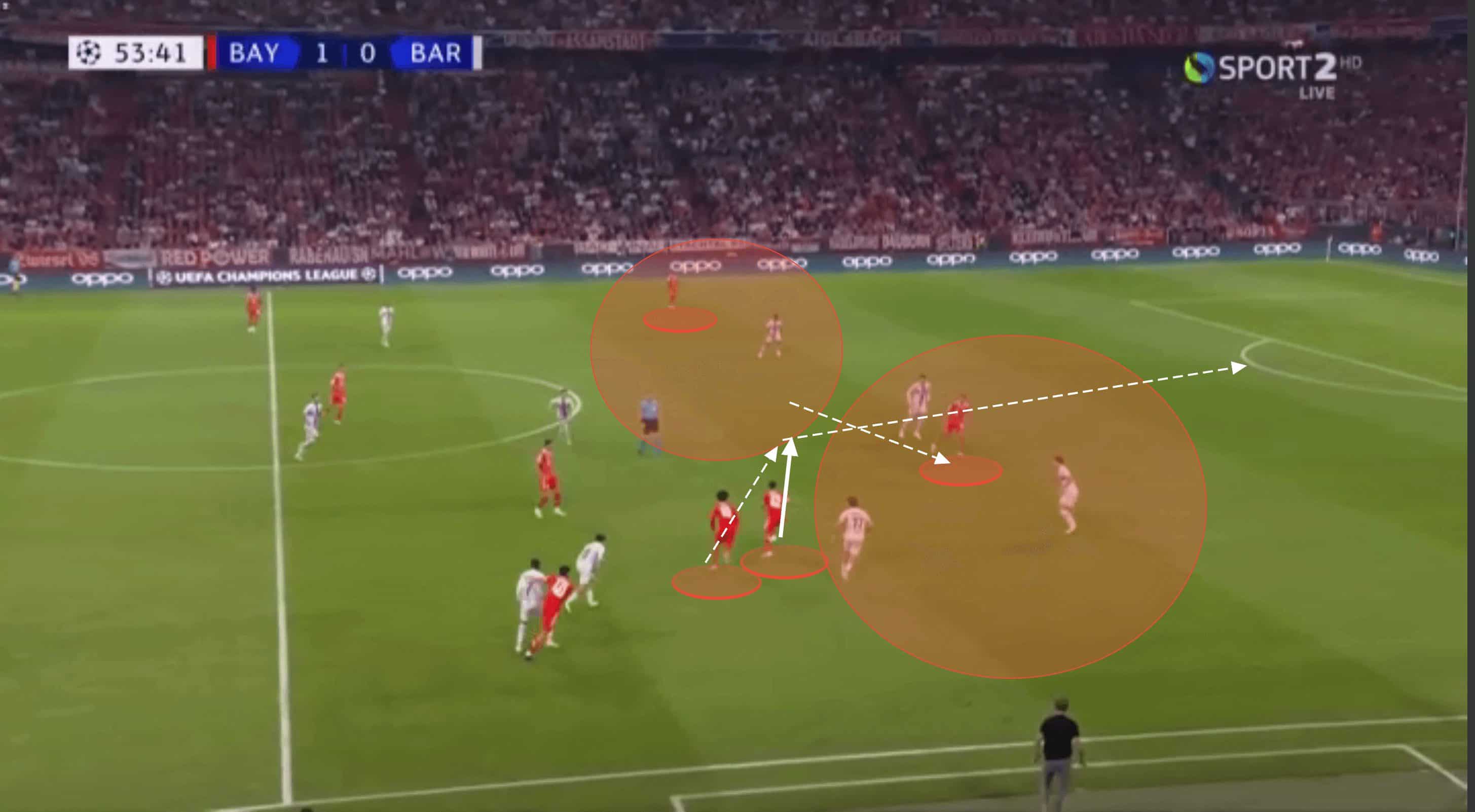
Let’s look again at the first Bayern goal but from a slightly later point than we referenced above. Look at the positioning of Mane on the far side as he has isolated a defender on that side. We then see Muller making a run towards the ball and essentially occupying the other central defender. These movements allow Sane to take the ball and break through the centre of the Barcelona defence with none of the Spanish side’s defenders capable of getting back and making an effective challenge on the ball.
Conclusion
The change in this match between the first and second half was striking and a lot of the credit for that should go to the Bayern coach Julian Nagelsmann. The German coach showed flexibility in terms of his system and his approach to the game and Bayern were able to take the pressure from Barcelona and then turn the tide in the second half.
For all that Lewandowski was central to the game in the first half of the pitch, he left Munich with no goals and, crucially, no points. It is definitely advantage Nagelsmann after this match.

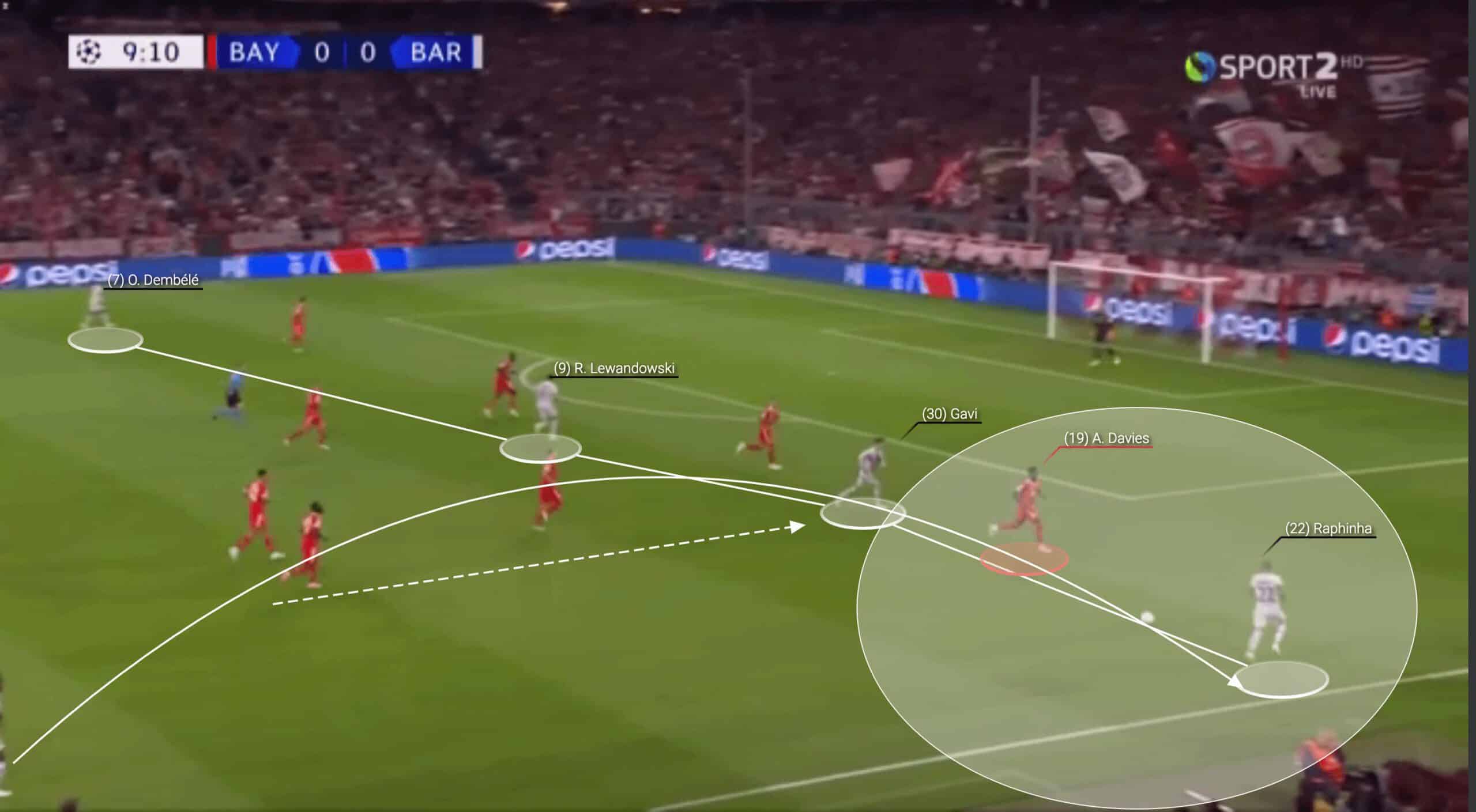



Comments